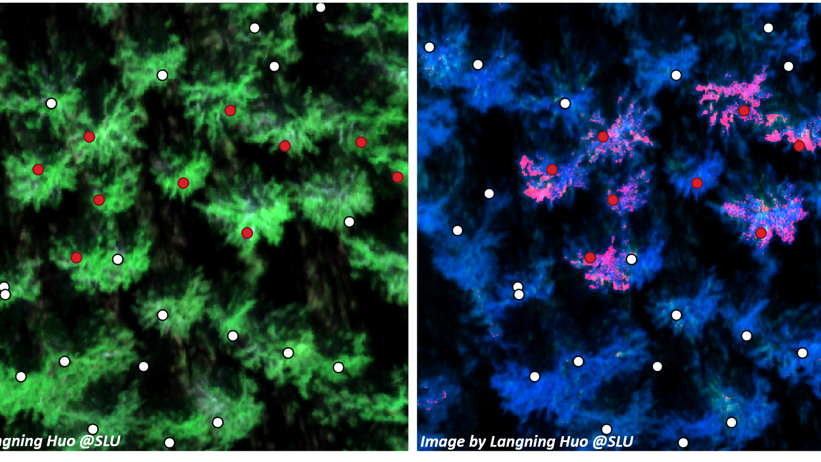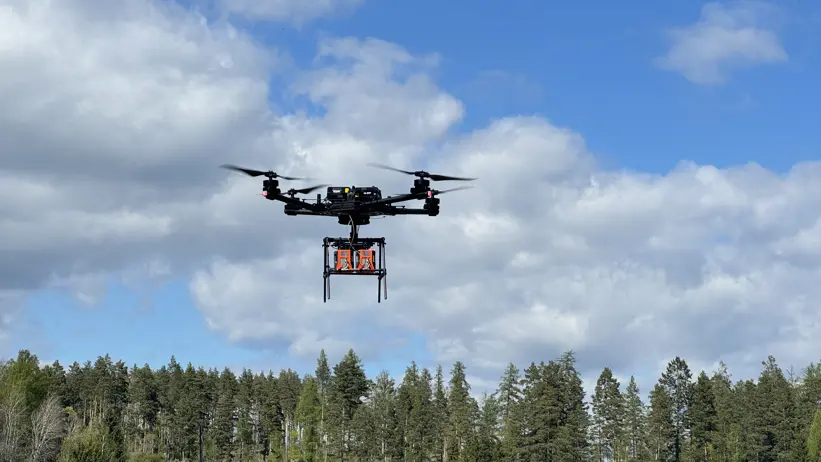
New discovery: How spruce bark beetle infestations can be detected early from the air
For the first time, researchers have detected spruce bark beetle infestations from the air at a very early stage, when the infestation has only affected one side of the tree trunk. The infestations are revealed by light reflections from the needles.
The discovery opens up possibilities for more effective control of the bark beetle.
‒ Forest damage caused by the spruce bark beetle costs landowners millions of Swedish kronor, and it is difficult to detect outbreaks in time. However, our method has the potential to completely change that. We obtain such detailed information that it is possible to detect differences in health between branches on the same tree, says Langning Huo, researcher at the Forest Damage Centre at the Swedish University of Agricultural Sciences.
The major outbreaks of spruce bark beetles began during the hot summer of 2018. Since then, around 34 million cubic metres of spruce timber have been destroyed in southern and central Sweden. When the insects bore into the trunk, they disrupt the tree’s water and nutrient transport. The tree then enters a stressed state that can lead to rapid death within weeks, when vital processes such as photosynthesis and transpiration shut down. Even after the tree has died, the needles can remain green for a long time before they finally discolour and fall off. This makes early detection extremely difficult. By the time an infested tree appears visibly brown to the human eye, the beetles have often already completed their development, left the tree as adults, and begun attacking new ones.
Hyperspectral cameras capture light far beyond what the human eye can see, recording hundreds of extremely narrow colour bands that reveal subtle changes in pigments, water content, and cell structure. This makes it possible to detect early biological stress in trees long before any visible damage appears. The researchers then focused on information that could be linked to stress and reduced vitality in trees and, based on this, discovered that light reflections can provide an early indication of deteriorating tree health.
‒ We use the very latest technology in this field, which opens up completely new opportunities for us, says Langning Huo.
Instead of focusing on chlorophyll, which is traditionally linked to tree stress, the researchers challenged this knowledge and looked at colour pigments belonging to the carotenoid group. When stress first hits, the tree does not immediately lose its green chlorophyll, but within hours it begins adjust by producing protective pigments such as carotenoids, which help shield cells from damage. It was this shift in focus that enabled them to detect the attacks so early and so clearly.

‒ The sooner the spruce bark beetle is detected, the better! Our technology makes it possible to detect trees that only show symptoms on one side, i.e. at a very early stage of the infestation, and reveals which side of the tree contains the most larvae. No one has previously been able to visualise stressed crowns so clearly, says Langning Huo.
Based on this knowledge, the researchers have developed models that can identify spruce bark beetle infestations at an early stage. The computer model developed by the researchers is better at detecting spruce bark beetle infestations than its forerunners. Furthermore, it does not require a control group of healthy trees to identify which trees are affected. Instead, the model clearly shows the symptoms on one side of the trees that have been attacked and at a very early stage. The study was conducted one year after the outbreak, but attacks can probably be detected even earlier during the outbreak years.
We hope that this method will be refined and become cheaper. We believe that it could be of great benefit to forest owners, who will be able to detect spruce bark beetles at an early stage and proactively control the damage such as peeling the bark to kill the larvae and remove infested trees from the forest, says Langning Hou.


Contact
-
Person
-
PersonTheres Svensson, CommunicatorFaculty of Forest Sciences